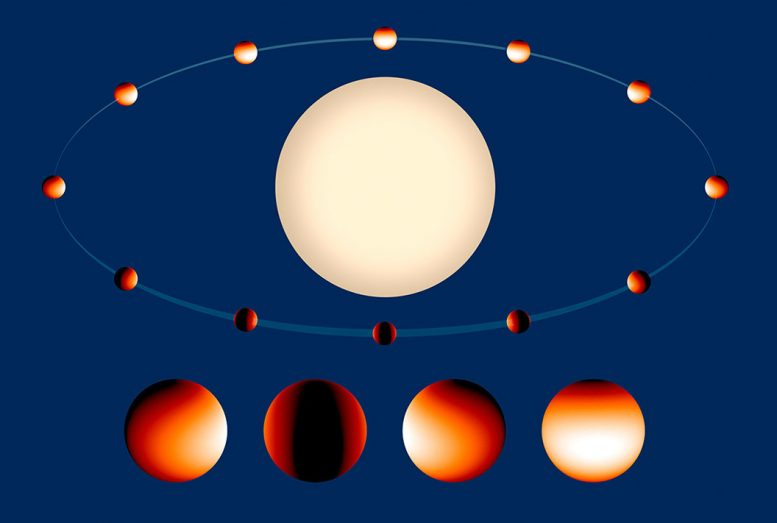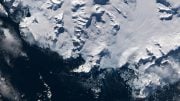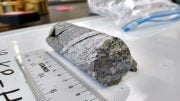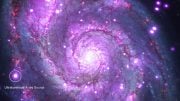
This is a temperature map of the “hot Jupiter” class exoplanet WASP 43b. The white-colored region on the daytime side is 2,800 degrees Fahrenheit (1,540 degrees Celsius). The nighttime side temperatures drop to under 1,000 degrees Fahrenheit (540 degrees Celsius). Credit: NASA/ESA
A team of astronomers used NASA’s Hubble Space Telescope to make the most detailed global map yet of the glow from a turbulent planet outside our solar system, measuring the temperature and tracing the amount and distribution of water vapor on exoplanet WASP-43b.
Hubble observations show the exoplanet, called WASP-43b, is no place to call home. It is a world of extremes, where seething winds howl at the speed of sound from a 3,000-degree-Fahrenheit (1,650-degree-Celsius) “day” side, hot enough to melt steel, to a pitch-black “night” side with plunging temperatures below 1,000 degrees Fahrenheit (540 degrees Celsius).
Astronomers have mapped the temperatures at different layers of the planet’s atmosphere and traced the amount and distribution of water vapor. The findings have ramifications for the understanding of atmospheric dynamics and how giant planets like Jupiter are formed.
“These measurements have opened the door for a new kind of ways to compare the properties of different types of planets,” said team leader Jacob Bean of the University of Chicago.
First discovered in 2011, WASP-43b is located 260 light-years away. The planet is too distant to be photographed, but because its orbit is observed edge-on to Earth, astronomers detected it by observing regular dips in the light of its parent star as the planet passes in front of it.
“Our observations are the first of their kind in terms of providing a two-dimensional map on the longitude and latitude of the planet’s thermal structure that can be used to constrain atmospheric circulation and dynamical models for hot exoplanets,” said team member Kevin Stevenson of the University of Chicago.
As a hot ball of predominantly hydrogen gas, there are no surface features on the planet, such as oceans or continents that can be used to track its rotation. Only the severe temperature difference between the day and night sides can be used by a remote observer to mark the passage of a day on this world.
The planet is about the same size as Jupiter, but is nearly twice as dense. The planet is so close to its orange dwarf host star that it completes an orbit in just 19 hours. The planet also is gravitationally locked so that it keeps one hemisphere facing the star, just as our moon keeps one face toward Earth.
This was the first time astronomers were able to observe three complete rotations of any planet, which occurred during a span of four days. Scientists combined two previous methods of analyzing exoplanets in an unprecedented technique to study the atmosphere of WASP-43b. They used spectroscopy, dividing the planet’s light into its component colors, to determine the amount of water and the temperatures of the atmosphere. By observing the planet’s rotation, the astronomers also were able to precisely measure how the water is distributed at different longitudes.
Because there is no planet with these tortured conditions in our solar system, characterizing the atmosphere of such a bizarre world provides a unique laboratory for better understanding planet formation and planetary physics.
“The planet is so hot that all the water in its atmosphere is vaporized, rather than condensed into icy clouds like on Jupiter,” said team member Laura Kreidberg of the University of Chicago.
The amount of water in the giant planets of our solar system is poorly known because water that has precipitated out of the upper atmospheres of cool gas giant planets like Jupiter is locked away as ice. But so-called “hot Jupiters,” gas giants that have high surface temperatures because they orbit very close to their stars, water is in a vapor that can be readily traced.
“Water is thought to play an important role in the formation of giant planets, since comet-like bodies bombard young planets, delivering most of the water and other molecules that we can observe,” said Jonathan Fortney, a member of the team from the University of California, Santa Cruz.
In order to understand how giant planets form astronomers want to know how enriched they are in different elements. The team found that WASP-43b has about the same amount of water as we would expect for an object with the same chemical composition as our sun, shedding light on the fundamentals about how the planet formed. The team next aims to make water-abundance measurements for different planets.
The results are presented in two new papers, one published online in Science Express Thursday and the other published in The Astrophysical Journal Letters on September 12.
The Hubble Space Telescope is a project of international cooperation between NASA and the European Space Agency. NASA’s Goddard Space Flight Center in Greenbelt, Maryland manages the telescope. The Space Telescope Science Institute (STScI) in Baltimore conducts Hubble science operations. STScI is operated for NASA by the Association of Universities for Research in Astronomy, Inc., in Washington.
References:
“Thermal structure of an exoplanet atmosphere from phase-resolved emission spectroscopy” by Kevin B. Stevenson, Jean-Michel Desert, Michael R. Line, Jacob L. Bean, Jonathan J. Fortney, Adam P. Showman, Tiffany Kataria, Laura Kreidberg, Peter R. McCullough, Gregory W. Henry, David Charbonneau, Adam Burrows, Sara Seager, Nikku Madhusudhan, Michael H. Williamson and Derek Homeier, 9 October 2014, Science.
DOI: 10.1126/science.1256758
arXiv: 1410.2241
“A Precise Water Abundance Measurement for the Hot Jupiter WASP-43b” by Laura Kreidberg, Jacob L. Bean, Jean-Michel Désert, Michael R. Line, Jonathan J. Fortney, Nikku Madhusudhan, Kevin B. Stevenson, Adam P. Showman, David Charbonneau, Peter R. McCullough, Sara Seager, Adam Burrows, Gregory W. Henry, Michael Williamson, Tiffany Kataria and Derek Homeier, 12 September 2014, The Astrophysical Journal Letters.
DOI: 10.1088/2041-8205/793/2/L27
arXiv: 1410.2255









Need to proof read -1000 F. Did the author mean -100 ?
No, I believe when the author states, “The nighttime side temperatures drop to under 1,000 degrees Fahrenheit,” they mean something like 990 degrees Fahrenheit…not negative F. They are trying to explain how hot the planet is, stating that even at night it is close to 1,000 F.